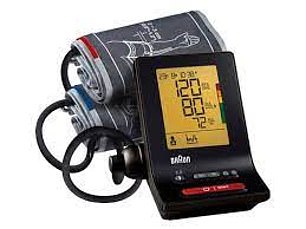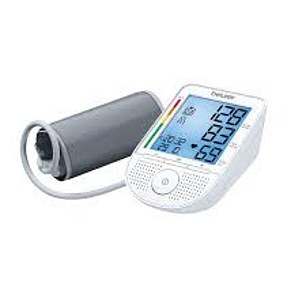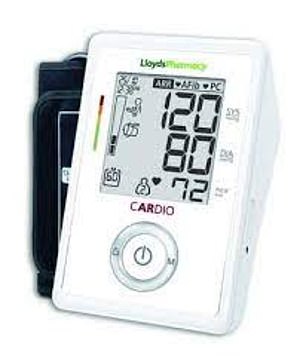Up to one in three Britons has high blood pressure, which raises the risk of heart attacks and strokes.
Normal blood pressure is less than 130 (systolic pressure) over 85 (diastolic); high blood pressure is 140/90 or greater.
Blood pressure readings at home are often a little lower, as you tend to be more relaxed. So if your home measurements are consistently higher than normal, it is important to see your doctor.
Here, Dr Scott Gall, a cardiologist at Blackpool Victoria Hospital, picks five of the best DIY monitors.
Omron EvolvAutomatic upper arm monitor
£129.99, boots.com

Unlike traditional upper arm monitors which pump air into a soft cuff via a tube, this is the newer generation of battery-powered cuffs. This model automa tically adjusts itself to the user’s arm — a good feature, as a badly fitting cuff may give false readings.
The built-in sensors measure the vibrations in the artery after the blood flow has been temporarily blocked (when the cuff is inflated) and then allowed to flow again once the cuff has been deflated. This is the standard way most upper arm cuff devices work, detecting the blood flow to record blood pressure.
A reading on the upper arm is the most common way of taking blood pressure and should be done after resting. It is good practice to take two or three readings (two minutes apart) and take an average of the results.
I like that this syncs with a smartphone, but non-tech-savvy users can still see readings on the screen on the cuff.
Braun ExactFit 5
£89.99, argos.co.uk

This monitor has two arm cuff sizes, which is useful for the correct fit and means two people can use the device. It has a colour-coded guide, which is a simple way of informing the user when they should see their GP.
This device states that it can detect an irregular heartbeat so could indicate atrial fibrillation, which is sometimes related to high blood pressure. This is when the heart beats abnormally and may cause palpitations.
But while a device like this can suggest if you might have atrial fibrillation, it cannot diagnose it — you need an ECG recording to do that. If the machine flags this up, see your GP to confirm the diagnosis.
Beurer BM49
£54.99, stressnomore.co.uk

This upper arm monitor reads aloud your blood pressure figures and heartbeats per minute, which may be useful to those with poor eyesight (sometimes caused by prolonged high blood pressure).
It also tells you how your own reading compares to guideline readings, and uses a ‘traffic light’ system if you are looking at the screen.
It does have irregular heartbeat detection — and the more expensive Beurer models claim to differentiate between atrial fibrillation (irregular heartbeat) and ectopics (extra heartbeats). However, this model is still useful to prompt the user to get checked for atrial fibrillation.
One potential downside is that there is no mention of validation for this particular model. Any home device should be clinically validated as adhering to European Society of Hypertension guidelines. Also, it only comes with one cuff size.

Lloyds Pharmacy cardio monitor
£69.99, lloydspharmacy.com
This machine has an arm cuff and some useful features such as detecting if the cuff is too loose or if your arm is moving — both of which could lead to inaccurate readings.
Most modern monitors like this have an irregular heartbeat detection function which is useful (this claims to differentiate between atrial fibrillation and ectopic heartbeats).
It also stores lots of readings (up to 120), which again would be useful for a long-term picture of your blood pressure.
Aktiia 24/7
£179.99, uk.aktiia.com

Unlike most blood pressure monitors, this goes around the wrist and is worn like a fitness tracker.
It uses a new type of technology involving optical sensors, which measure the diameter of the arteries as they change during each heartbeat. This data is then used to estimate the user’s blood pressure.
Measuring your blood pressure in the upper arm can be easier than at the wrist as the latter must be at heart level (your upper arm is naturally in that position) or it can be inaccurate. But if the wrist is in the correct position both are acceptable.
This device needs to be calibrated with an arm cuff, every 30 days to ensure the readings are accurate. The calibration takes place when the device is paired with an app and a Bluetooth-enabled blood pressure cuff.
With this bracelet offering continuous monitoring, it may be useful in giving a better overall picture of someone’s blood pressure.
But it is important to recognise that blood pressure will vary throughout the day due, for example, to different levels of exertion — sitting, walking, exercising — so users should not be worried by some high readings.
The device has several potential benefits: the strap may be helpful for patients who find the inflating cuff uncomfortable, and it can assess blood pressure overnight without waking the user.
However, the device is expensive and can’t be used by patients with heart issues such as atrial fibrillation as it is currently unable to capture the signals of this as the pulse can be unstable.
It is also not recommended for those over 65 or with health issues such as diabetes as again the pulse can be erratic and give misleading blood pressure readings.
Source link : https://www.dailymail.co.uk/health/article-9877559/Top-blood-pressure-monitors-chosen-heart-doctor.html











